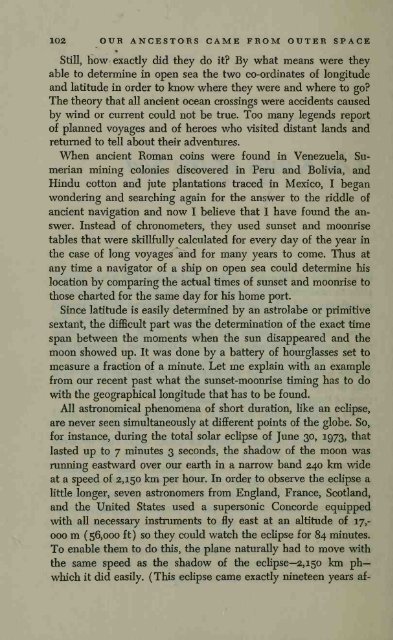You also want an ePaper? Increase the reach of your titles
YUMPU automatically turns print PDFs into web optimized ePapers that Google loves.
102 OUR ANCESTORS CAME FROM OUTER SPACE<br />
Still, fiow exactly did they do it? By what means were they<br />
able to determine in open sea the two co-ordinates of longitude<br />
and latitude in order to know where they were and where to go?<br />
The theory that all ancient ocean crossings were accidents caused<br />
by wind or current could not be true. Too many legends report<br />
of planned voyages and of heroes who visited distant lands and<br />
returned to tell about their adventures.<br />
When ancient Roman coins were found in Venezuela, Sumerian<br />
mining colonies discovered in Peru and Bolivia, and<br />
Hindu cotton and jute plantations traced in Mexico, I began<br />
wondering and searching again for the answer to the riddle of<br />
ancient navigation and now I believe that I have found the answer.<br />
Instead of chronometers, they used sunset and moonrise<br />
tables that were skillfully calculated for every day of the year in<br />
the case of long voyages and for many years to come. Thus at<br />
any time a navigator of a ship on open sea could determine his<br />
location by comparing the actual times of sunset and moonrise to<br />
those charted for the same day for his home port.<br />
Since latitude is easily determined by an astrolabe or primitive<br />
sextant, the difficult part was the determination of the exact time<br />
span between the moments when the sun disappeared and the<br />
moon showed up. It was done by a battery of hourglasses set to<br />
measure a fraction of a minute. Let me explain with an example<br />
from our recent past what the sunset-moonrise timing has to do<br />
with the geographical longitude that has to be found.<br />
All astronomical phenomena of short duration, like an eclipse,<br />
are never seen simultaneously at difiFerent points of the globe. So,<br />
for instance, during the total solar eclipse of June 30, 1973, that<br />
lasted up to 7 minutes 3 seconds, the shadow of the moon was<br />
running eastward over oin: earth in a narrow band 240 km wide<br />
at a speed of 2,150 km per hour. In order to observe the ecHpse a<br />
little longer, seven astronomers from England, France, Scotland,<br />
and the United States used a supersonic Concorde equipped<br />
with aU necessary instruments to fly east at an altitude of 17,-<br />
000 m (56,000 ft) so they could watch the eclipse for 84 minutes.<br />
To enable them to do this, the plane naturally had to move with<br />
the same speed as the shadow of the ecHpse—2,150 km ph—<br />
which it did easily. (This eclipse came exactly nineteen years af-

















